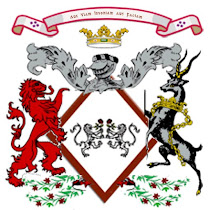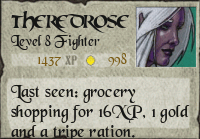First the announcement:
I am pleased to inform you, gentle readers, that I am hosting a Beltane Festival in Caledon Loch Avie on May 1st. We will begin the celebration at 6:30pm SLT and anticipate the festivities will continue until at least 10:00pm SLT. I encourage you to channel your inner God and Goddess. Please feel free to attend in druidic robes, faerie costumes, elvin or gnomish garb, medieval dress, or Victorian-wear. The evening will begin with a knighting ceremony and introduction of several members of the Loch Avie court. I will then light the Beltane Need Fires in a ceremony that I hope you will all enjoy. The rest of the evening will be devoted to the pleasure of your company. DJ Gabrielle will be providing the music for us during the entire event. She and I will be discussing my eclectic vision for the programming later this week. Of course there will be dancing! We have a wonderful Maypole, built by Lady Kate Nicholas and scripted by ZenMondo Wormser, for traditional revelry. Should the events of the evening inspire you, there will also be hidden throughout the Loch various areas for your inner Green Men and May Queens to meet and ensure the fertility of the land for the coming year. Pleasures abound!
Now the history:
Beltane is an old Celtic Fire Ritual which celebrates, at the most fundamental level, the end of winter and the beginning of the warmer, lighter half of the year. It is the counterpart to Samhain, which marks the Pagan New Year and celebrates ancestors and the death of the crops (harvest). Beltane celebrates life. For the Celts, it was a festival that insured fertility and growth.
Beltane is one of the four major Sabbats in the Celtic tradition, the other three being Lammas, Samhain and Imbolc. Beltane's traditional date, May 1st, was chosen as the midway point between the vernal equinox and summer solstice (two of the four minor Sabbats). Due to the change in the earth's axis of rotation over time, this point is now closer to May 5th, and some pagans observe May 5th as "Old Beltane," but the traditional date is still favored.
Beltane, much like Samhain, has changed over the years. Some traditions existed only in a single village, while others were found throughout the culture. It is believed that Beltane is a Celtic reinvention of an even older Roman festival, Floralia, which celebrated the goddess Flora and the flowering of spring. Most major religions have a holiday that marks the coming of spring. The Christian religion celebrates rebirth (or resurrection) on Easter; Easter eggs, Easter bunnies, chicks, and lilies are all pagan symbols of fertility associated with spring, adapted to the Christian tradition. The Hindu religion celebrates Holi, a carnival-like spring festival, dedicated to Krishna or Kama, the God of Pleasure. This festival resembles Beltane, with bonfires being a main focus of the holiday.
The Goddess, Floralia. By Evelyn DeMorgan
Traditionally, Beltane festivities began days before May 1st or "May Day," when villagers traveled into the woods to gather the nine sacred woods needed to build the Beltane bonfires. The tradition of "May Boughing" or "May Birching" involved young men fastening garlands of greens and flowers on the windows and doors of their prospective ladyloves before the fires are lit Beltane night. As with many Celtic customs, the type of flowers or branches used carried symbolic meaning, and much negotiating and courting could be worked out ahead of time.
Many communities elected a virgin as their "May Queen" to lead marches or songs. To the Celts, she represented the virgin goddess on the eve of her transition from Maiden to Mother. Depending on the time and place, the consort might be named "Jack-in-the-Green" or "Green Man," "May Groom" or "May King." The union of the Queen and her consort symbolized the fertility and rebirth of the world.
Because the Celtic day started and ended at sundown, the Beltane celebration would begin at sundown on April 30th. After extinguishing all hearth fires in the village, two Beltane fires were lit on hilltops. The villagers would drive their livestock between the fires three times, to cleanse them and insure their fertility in the coming summer, and then put them to summer pasture. Then the human part of the fertility ritual would begin.
William Holdman Hunt's The Hireling Shepherd
As dancing around the bonfires continued through the night, customary standards of social behavior were relaxed. It was expected that young couples would sneak off into a ditch, the woods or, better yet, a recently plowed field for a little testing of the fertility waters. Even after hand-fasting was replaced by the Christian tradition of monogamous marriage, the Beltane ritual continued with a new tradition: all marriage vows were temporarily suspended for the festival of Beltane. Many a priest would lament the number of virgins despoiled on this one night, but the tradition persevered. Babies born from a Beltane union were thought to be blessed by the Goddess herself.
Beltane, like Samhain, is a time when the veil between the worlds is thought to be thin, a time when magic is possible. Whereas Samhain revelers must look out for wandering souls of the dead, Beltane merrymakers must watch for Fairies.
The maypole, which was either a permanent feature or cut in a ceremony during the gathering of the nine sacred woods, was a symbolic union of the God and Goddess. The maypole itself represented the male, a phallus thrust into mother earth, while the ribbons that were wound around it represent the enveloping nature of the woman and her womb. The maypole was usually danced after sunrise, when disheveled men and women would stagger back into town carrying flowers they picked in the forests or fields. The area around the maypole was decorated with the flowers, and then the winding of the ribbons would begin.
These wildwood antics have inspired writers such as Kipling:
Oh, do not tell the Priest our plight,
Or he would call it a sin;
But we have been out in the woods all night,
A-conjuring Summer in!
And Lerner and Lowe:
It's May! It's May!
The lusty month of May!...
Those dreary vows that ev'ryone takes,
Ev'ryone breaks.
Ev'ryone makes divine mistakes!
The lusty month of May
Even as we have fun with contests on the battlefield and in the arena, let us not forget the (other) pleasures of life, the celebration of friendships and of love, and the ancient rites.
Slainte! My friends. Health and Happiness!
Swank & Co at Fantasy Faire 2022
3 years ago



3 comments:
Your Grace, if I can ever get my (explitive deleted) computer to work, or a new one, I (and my lover 98) will be there! And thanks for all the great info!!!!!!
Lady Amber
Oh, and absolutely great piccies by the way! :)
A wonderful essay! To add to the literary selections at the end, I recall that Herrick has an entire poem on this
here.
My best your Grace.
Tele
Post a Comment